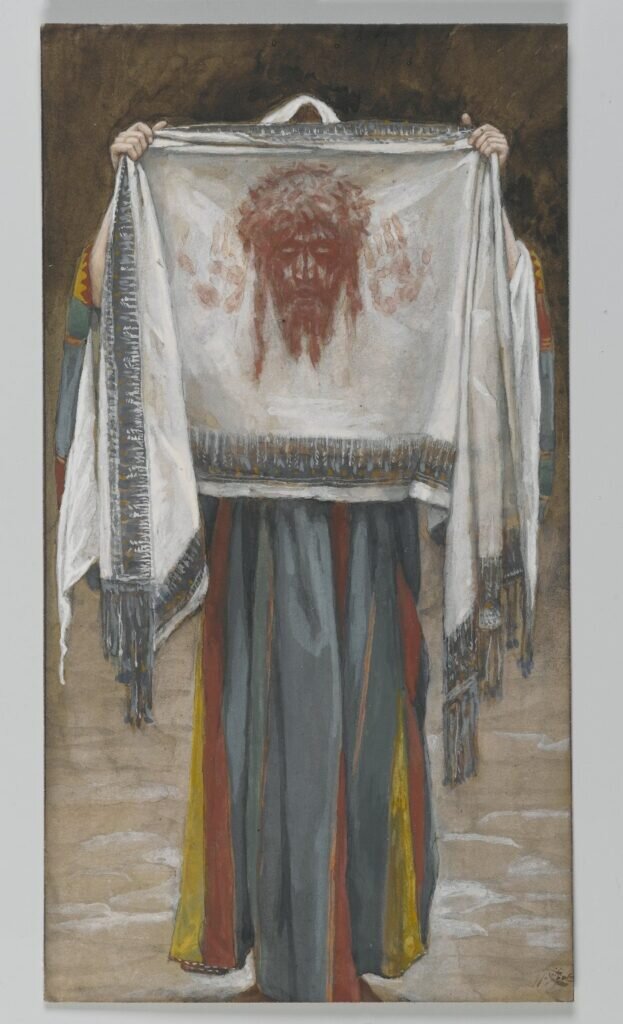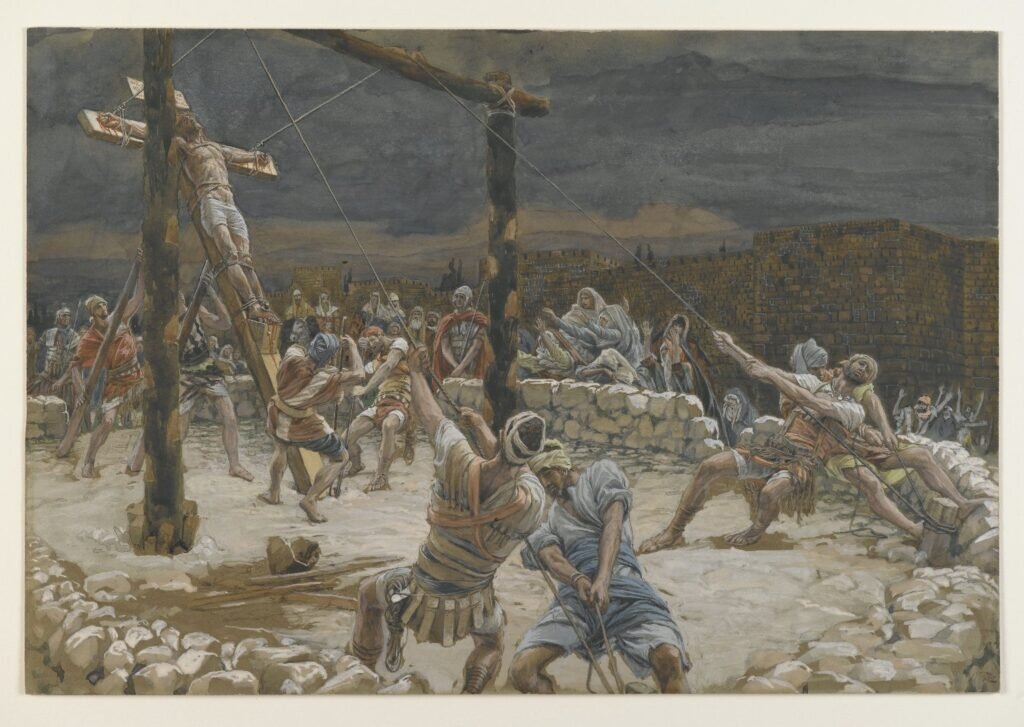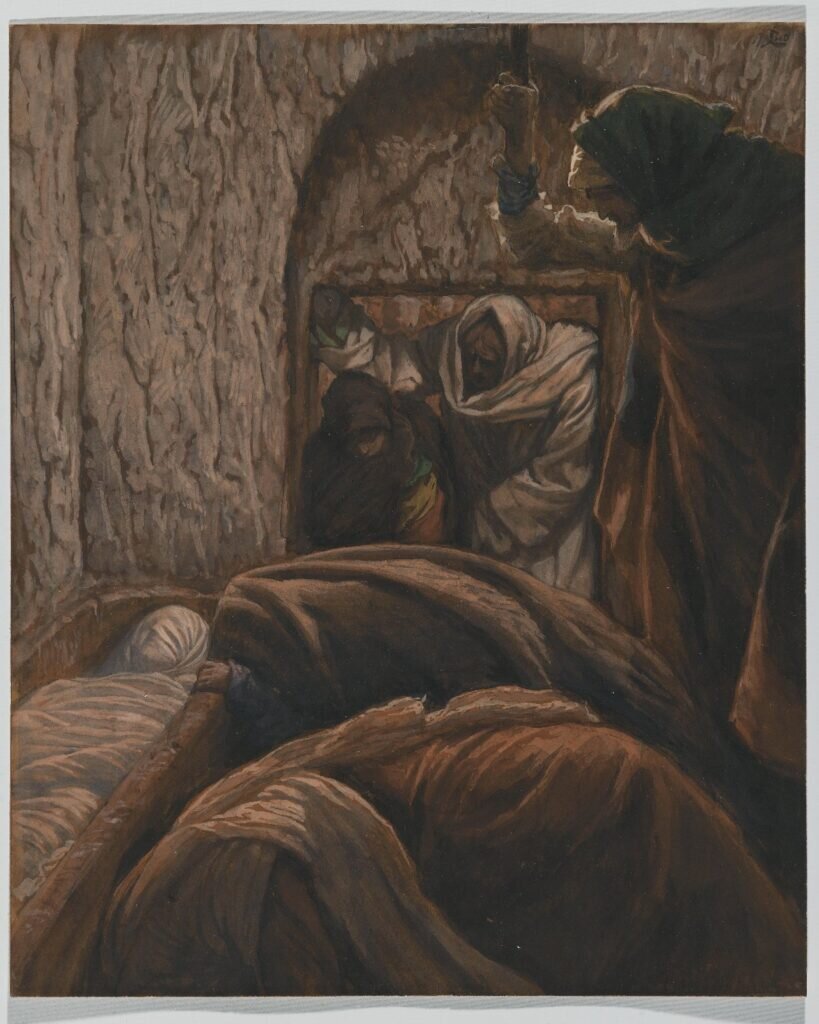Holy Week Illustrated by James Tissot: Good Friday
Selected illustrations for Good Friday
+ Peter's First Denial of Jesus
+ Peter's Second Denial of Jesus
+ The Third Denial of Peter. Jesus' Look of Reproach
+ The Cock Crowed
+ The Sorrow of St. Peter
+ Jesus Meets His Mother
+ The Holy Face+ The Raising of the Cross
+ What Our Lord Saw from the Cross
+ The Dead Appear in the Temple
+ Jesus in the Sepulchre
The titles of Tissot's images for the events of Good Friday not shown on this page are linked to where the images may be viewed at another site with accompanying Bible verses.
Peter's First Denial of Jesus
John 18:15-17: "Simon Peter and another disciple were following Jesus. Because this disciple was known to the high priest, he went with Jesus into the high priest's courtyard, but Peter had to wait outside at the door."The other disciple, who was known to the high priest, came back, spoke to the girl on duty there and brought Peter in."'You are not one of his disciples, are you?' the girl at the door asked Peter."He replied, 'I am not.'"Brooklyn Museum Commentary: "When warned by Jesus [on Holy Thursday] that he would deny him three times before the cock crowed—before the dawn—Peter vehemently objected, asserting his fidelity and pledging to die alongside Jesus."However, the prophecy is realized. Peter first denies his status as a disciple to the maidservant who points an accusatory finger at him while guarding the door to the chief priest’s chamber."
Peter's Second Denial of Jesus
John 18:18, 25: "It was cold, and the servants and officials stood around a fire they had made to keep warm. Peter also was standing with them, warming himself...."As Simon Peter stood warming himself, he was asked, 'You are not one of his disciples, are you?'"He denied it, saying, 'I am not.'"Brooklyn Museum Commentary: "Later, admitted to the priest’s rooms, where he warms himself by the fire, Peter again rejects the association when asked a second time; his hands are raised in protest as all await his response."Annas and Caiaphas*The Torn Cloak: Jesus Condemned to Death by the Jews
The Third Denial of Peter. Jesus' Look of Reproach
Luke 22:59-61: "About an hour later another asserted, 'Certainly this fellow was with him, for he is a Galilean.'"Peter replied, 'Man, I don't know what you're talking about!'"Just as he was speaking, the rooster crowed. The Lord turned and looked straight at Peter. Then Peter remembered the word the Lord had spoken to him: 'Before the rooster crows today, you will disown me three times.'"Brooklyn Museum Commentary: "Finally, questioned a third time, Peter again denies knowing Jesus, just as the cock crows. Betrayed by his disciple, as he had foretold, Jesus in this image looks in Peter’s direction with sadness, as he is escorted away by a jeering crowd. Peter hides from view behind a thick stone archway, his arm covering his face."
The Cock Crowed
Brooklyn Museum Commentary: "Eager to provide insight into the precise timing of the events as they unfolded, Tissot in his commentary refers to his experiences of the Middle East and suggests that the rooster’s third crowing must have occurred at around three in the morning."
The Sorrow of St. Peter
Luke 22:61: "And he went outside and wept bitterly."
Christ Is Mocked in the House of Caiaphas
Good Friday Morning: Jesus in Prison
The Morning Judgment
Judas Returns the Blood Money
Judas Hangs Himself
Having Deserted Jesus, the Disciples Hide in the Valley of Hinnom
Jesus Is Led from Caiaphas to Pilate
Jesus Appears before Pilate for the First Interview
Portrait of Pontius Pilate*
Pilate's Wife Warns Him of a Dream
Jesus Before Herod
Jesus Is Led Back from Herod to Pilate
The Scourging on the Front
The Scourging on the Back
The Scapegoat*
The Crowning of Thorns
Behold the Man. Ecce Homo
Jesus Appears before Pilate for the Second Interview
Barabbas*
Let Him Be Crucified!
Pilate Washes His Hands
The Holy Stairs
Jesus Leaves the Praetorium
Bird's-Eye View of the Forum
The Judgment on the Gabbatha
The Title on the Cross
They Put His Own Clothes on Him
Jesus Bearing the Cross
Jesus Falls Beneath the Cross
Jesus Meets His Mother
Brooklyn Museum Commentary: "Although this episode cannot be found in the Gospel accounts, Tissot presents a scene traditionally included as one of the Stations of the Cross, a series of images, venerated chiefly by Catholics, that trace the events of Jesus’ final hours. At the fourth station, he meets his mother, Mary, after he falls while carrying his cross to Calvary. Her arms extended toward her son, Mary rushes to his side, accompanied by John the Evangelist and Mary Magdalene. Her compassion stands in marked contrast to the cruelty of his tormentors, who whip him and brandish the nails that will be used to affix him to the cross."
Simon the Cyrenian Compelled to Carry the Cross with Jesus
Simon of Cyrene and his two sons Alexander and Rufus*
A Holy Woman Wipes the Face of Jesus
The Holy Face
For more on the tradition of St. Veronica wiping Jesus' face see the Catholic Encyclopedia.
The Daughters of Jerusalem
The Procession Nearing Calvary
The Holy Women Watch from Afar
The disciples, having left their hiding place, watch from afar
Jesus is taken from the old cistern*
Jesus Stripped of His Clothing
Wine Mixed with Myrrh or Gall
The First Nail
The Nail Driven into the Feet
The Raising of the Cross
Brooklyn Museum Commentary: "Tissot renders the technical elements of the Crucifixion with a profusion of unforgettable details intended to encourage viewers to contemplate the method of Christ’s execution on a visceral level. Although Tissot follows celebrated artistic predecessors such as the Flemish painter Peter Paul Rubens (1577–1640) in his depiction of the brute physical exertions required of those who raised the cross, he also adds further nuances to the visual tradition, depicting the elaborate system of ropes, poles, and scaffolding employed in the operation. Once in place, Tissot explains, the base of the cross would be set into a post hole and then reinforced with wedges to maintain its stability."
The Five Wedges of the Cross
Pardon of the Good Thief
They Parted His Raiment and Cast Lots
And Sitting Down They Watched Him There
What Our Lord Saw from the Cross
Brooklyn Museum Commentary: "In the most memorable, and even notorious, of Tissot’s images, Christ looks out at the crowd of spectators arrayed before him: Mary Magdalene, in the immediate foreground, with her long red tresses swirling down her back, kneels at his feet, which are clearly visible at the bottom center of the composition. Beyond her, the Virgin Mary clutches her breast, while John the Evangelist looks up with hands clasped."The artist here adopts the point of view of Christ himself. Few painters have conceived a composition this daring. In his audacity, however, Tissot remains true to his artistic vision: ultimately, the image is an exercise in empathy. Its point is to give viewers, accustomed to looking at the event from the outside, a rare opportunity to imagine themselves in Christ’s place and consider his final thoughts and feelings as he gazed on the enemies and friends who were witnessing, or participating in, his death."
Woman, Behold Your Son (Sabat Mater)
The Sorrowful Mother (Mater Dolorosa)
My God, why hast Thou forsaken me?
I thirst. Vinegar given to Jesus
It is finished! (Consummatum est!)
The Death of Jesus
The Crowd Left Beating their Breasts
Earthquake
The Chasm in the Rock in the Cave beneath Calvary*
The Confession of Saint Longinus
The Centurion*
The Dead Appear in the Temple
Matthew 27:52-53: "The tombs broke open and the bodies of many holy people who had died were raised to life. They came out of the tombs, and after Jesus' resurrection they went into the holy city and appeared to many people."Brooklyn Museum Commentary: "While the scenes of the Crucifixion examine the precise mechanics of the execution, lending a credible veracity to the ancient events, this image takes a more mystical or fantastical approach."Immediately after the death of Jesus, Matthew writes, tombs broke open and the bodies of many holy persons who had died came back to life, went into the city, and showed themselves to the people. Tissot paints the risen dead as spectral forms, flying through Jerusalem and the Temple precinct, scattering the living, who fear that contact with the dead will defile them. In the Temple, resurrected priests, garbed in the costume of their rank, fly through the court, rising like the smoke from the altar of burnt sacrifice."
The Dead Appear in Jerusalem
The Thieves' Legs Are Broken
The Soul of the Penitent Thief
A Soldier Pierces Jesus in His Side with a Spear
Confession of the Centurion
Jesus Alone on the Cross
Joseph of Arimathea
The Descent from the Cross
The Holy Virgin Receives the Body of Jesus
The body of Jesus is carried to the anointing stone
The Holy Virgin kisses the face of Jesus before it is wrapped in the winding-sheet
Jesus Carried to the Tomb
Jesus in the Sepulchre
John 19:38b-42: "With Pilate’s permission, [Joseph of Arimathea] came and took the body away. He was accompanied by Nicodemus, the man who earlier had visited Jesus at night. Nicodemus brought a mixture of myrrh and aloes, about seventy-five pounds. Taking Jesus’ body, the two of them wrapped it, with the spices, in strips of linen. This was in accordance with Jewish burial customs. At the place where Jesus was crucified, there was a garden, and in the garden a new tomb, in which no one had ever been laid. Because it was the Jewish day of Preparation and since the tomb was nearby, they laid Jesus there."
Reconstruction of Golgotha and the Holy Sepulchre Seen from the Wall of Herod's Palace
Reconstruction of Golgotha and the Holy Sepulchre seen from the Walls of the Judical Gate or Gate of Judgment
Reconstruction of Jerusalem and Herod's Temple
Man of Sorrows
This is one of a series of posts for Holy Week.
Holy Week Illustrated by James Tissot: Palm Sunday
Holy Week Illustrated by James Tissot: Monday
Holy Illustrated by James Tissot: Tuesday
Holy Week Illustrated by James Tissot: Wednesday
Holy Week Illustrated by James Tissot: Holy Thursday
Holy Week Illustrated by James Tissot: Holy Saturday
Holy Week Illustrated by James Tissot: Easter Sunday
After his conversion back to the faith of his childhood, James Jacques Tissot, French realist painter of worldly scenes, took three arduous trips to the Holy Land to seek out and record authentic details about the people, the landscape, the architecture, and the way of life. On his return he created a series of goache (opaque watercolor) illustrations that he later published with great success in a book with the title, The Life of Our Saviour Jesus Christ: Three Hundred and Sixty-Five Compositions from the Four Gospels with Notes and Explanatory Drawings.
In 1896, the illustrations were sent on a trans-Atlantic tour, where they were displayed in London, New York, Boston, Philadelphia and Chicago, and attracted throngs wherever they were shown. In 1900, the illustrations along with Tissot's preliminary drawings and notes were purchased on the advice of John Singer Sargent for the huge sum of $60,000 to be the centerpiece collection of the newly formed Brooklyn Museum of Art—with the help of thousands of subscriptions from average citizens. The images in this series are from the Brooklyn Museum and Wikimedia.
"RIGHTS STATEMENT No known copyright restrictions."
James Tissot: The Life of Christ, 2009, from the last major exhibition of his watercolors, which were removed from exhibition in 1930.












